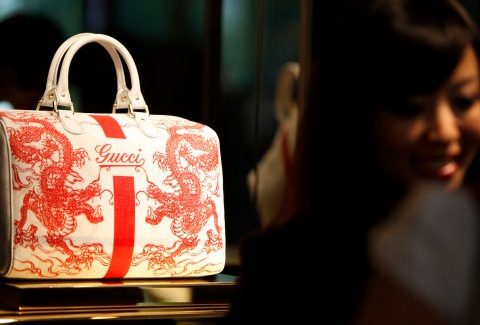The luxury industry in China accounted for 29% of the global market in 2015 and continues to grow at an envious rate by western standard, despite the recent slowdown. Changes are occurring in Chinese customers’ expectations but also in their consumption patterns. KPMG realized in 2015 a survey of more than 10,000 mainlanders and found 45% of respondents purchased most of their luxury items online.
Luxury industry in China: Luxury brands are suffering in a sluggish Chinese luxury market

The luxury industry in China has slow down in 2015, as it dipped two percent to RMB113 billion. It was driven by a decline in men’s wear, watches, and leather goods. This slowdown is caused by the fact that luxury goods have become less accessible to the growing Chinese middle class and less acceptable for members of China’s elite, as the government’s anti-corruption campaign, launched in 2013, has a chilling effect on demand for luxury fashion and fine jewelry. Moreover, the volatility of the stock market strongly influences Chinese consumers’ luxury goods consumption. In the first half of 2015, a good stock market performance restored Chinese consumers’ confidence in purchasing luxury products, particularly luxury jewelry, but since the middle of 2015, stock market fluctuation has brought uncertainty for the Chinese economy.
As a consequence, luxury brands are suffering and some have to close their stores in China. “A corollary to the drop in domestic sales is a reduction of the store footprint by most brands, with a greater focus on fewer, larger, and better-located stores,” Bain & Company stated in its report on the luxury industry in China in 2015. In November 2015, Burberry posted worse than expected results, blaming poor sales in the country. The British brand closed two stores in China in 2015. In early 2016, Prada blamed the economic crackdown for its first fall in profit in four years, which dropped by 28%. The brand had to close four stores located in China in 2015. The industry is also resetting its long-term expectations. For the period from 2017 to 2020, Bain & Company expects 2-3% growth, down from a yearly average of 6% for the two decades to 2015.
Among Chinese luxury goods consumers’ criteria, quality and newness have taken over brand name and logo
The slowdown in the luxury industry in China goes along with a shift in consumers’ consumption patterns. “In the past, luxury goods were seen as a symbol of wealth and status for Chinese consumers. Now they buy luxury goods for their own enjoyment,” says Dr. Tina Zhou of the luxury research consultancy Fortune Character Institute. Luxury items purchases are now more about indulging oneself rather than gifting or bribes.
Chinese consumers’ tastes have also shifted away from visibly branded goods for quality, newness, and lifestyle. The research realized by Fortune Character Institute shows that 39% of wealthy Chinese think the logo is no longer the priority. “Niche high-end brands, as well as bespoke products, are becoming the new driver of luxury consumption,” according to Dr. Zhou. The market is becoming mature, and the Chinese customers are “becoming a lot more global” and “more confident” according to Andrew Keith, president of Lane Crawford. They are looking for something different from the Burberry plaids or the LV-emblazoned bags. This is why Chinese malls are seeing increased demand for niche brands, often in response to reviews on social media and on blogs according to Barclays report. To capture the next generation of trendy customers in the Chinese market, luxury companies must place greater emphasis on making their brands “younger” and more fashionable. Above all, luxury brands will have to increase focus on “exclusivity” both regarding product design and store footprint.
As Chinese consumers turn to e-commerce, luxury brands need to sell online and establish their presence on social networks, namely on WeChat
 In the report “China’s Luxury Market – Losing Sheen?” released by research group Aranca, another change in the Chinese consumers’ behavior is their growing preference for online retailers over brick-and-mortar stores. Currently, digital is a small part of the luxury industry in China – only 5% of the industry in 2015 –, but it is growing at triple the rate of the overall market. Tmall is one of China’s biggest online marketplaces, and it teamed up in early 2016 with Mei.com, a pioneer in selling luxury, to create a new channel to bring more luxury and premium fashion brands to Chinese online shoppers. Mei.com allows luxury brands to be introduced to Tmall without requiring them to set up official stores on the platform. Brands such as Burberry, Calvin Klein, and Lacoste have set up Tmall stores. However, most of the high-end luxury brands don’t have their official stores on Tmall and sell on global e-commerce platform such as Yoox-Net-a-Porter to Chinese consumers, even though many expected that Burberry’s launch on Tmall in April 2014 would pave the way for them to follow. Accessible luxury brands are more proactive on China’s e-commerce platforms. For example, Hugo Boss has its lower-end Boss Orange line on Tmall, and Coach was recognized as the third most digitally efficient brand in China, according to L2’s 2016 Digital IQ Index.
In the report “China’s Luxury Market – Losing Sheen?” released by research group Aranca, another change in the Chinese consumers’ behavior is their growing preference for online retailers over brick-and-mortar stores. Currently, digital is a small part of the luxury industry in China – only 5% of the industry in 2015 –, but it is growing at triple the rate of the overall market. Tmall is one of China’s biggest online marketplaces, and it teamed up in early 2016 with Mei.com, a pioneer in selling luxury, to create a new channel to bring more luxury and premium fashion brands to Chinese online shoppers. Mei.com allows luxury brands to be introduced to Tmall without requiring them to set up official stores on the platform. Brands such as Burberry, Calvin Klein, and Lacoste have set up Tmall stores. However, most of the high-end luxury brands don’t have their official stores on Tmall and sell on global e-commerce platform such as Yoox-Net-a-Porter to Chinese consumers, even though many expected that Burberry’s launch on Tmall in April 2014 would pave the way for them to follow. Accessible luxury brands are more proactive on China’s e-commerce platforms. For example, Hugo Boss has its lower-end Boss Orange line on Tmall, and Coach was recognized as the third most digitally efficient brand in China, according to L2’s 2016 Digital IQ Index.
Luxury brands have been held back from e-commerce for fear of diluting their brand. By selling on online platforms such as Tmall, they will gain access to 400 million consumers, but they will have to face new challenges. Brands will need to maintain consistency in their pricing strategy and constantly work on keeping their luxury image to avoid ‘over-communication.’ On the other hand, Chinese buyers also have concerns about authenticity when purchasing luxury goods online, especially when buying luxury designer clothing and leather goods. Alibaba is battling counterfeit goods on its platform Tmall with a new counterfeit detection tool rolled out in July, but its measures have been insufficient as Coach shut down its portal on Tmall in early September, reducing its China e-commerce sales channels to a standalone online store and WeChat shop.
When it comes to WeChat and social networks, luxury brands have adapted to them to increase their visibility and desirability. Fashion and watch and jewelry brands have built their presence on Sina Weibo, WeChat, and Youku Tudou. Presence on WeChat is a means to connect directly and in a personalized manner with consumers, to share their heritage, their retail locations, and provide authenticity checks. Chow Tai Fook has a dedicated WeChat loyalty program section where users can check loyalty points, orders, coupons, and sign up for brand activities. On its WeChat account, Chaumet offers appointment booking for in-store service in China, and this feature is not available on its website. Brands can even sell through WeChat shops as Coach already does it, but this is not yet common practice. In a country where mobile traffic is almost twice as high as desktop traffic, mobile commerce is likely to be the future for luxury brands in China.
See also our services: Strategic consultancy in China
Stay Updated! Follow us on Facebook:





